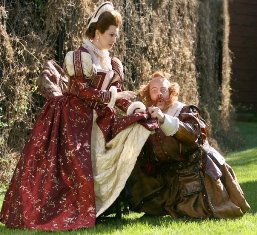
CCM's Falstaff" Leaves Them Laughing
Bravo CCM, which continues to feed Cincinnati’s considerable appetite for opera.

Speaking of appetite, the University of Cincinnati College-Conservatory of Music presented Verdi’s “Falstaff” Thursday evening in Corbett Auditorium.
Shakespeare’s tale about the corpulent knight who over-indulges in trying to satisfy his cravings for sex and money closed the school’s 2008-09 main stage opera season.
It also marked the main stage directing debut of CCM’s new opera department chair Robin Guarino. The zest with which Guarino led her charges was nowhere more evident than in the way she repeatedly hustled them to the lip of the stage to acknowledge the final applause.
“Falstaff” (1893) was Verdi’s last opera, the product of a fertile octogenarian who lavished his affection as well as his consummate mastery upon it, recalling Mozart, Rossini and the great Italian buffa tradition that preceded it.
The opening night cast was headed by baritone Jonathan Lasch as Falstaff. A second-year artist’s diploma student from Plymouth, Minnesota, Lasch targeted his character in a handsome voice colored skillfully to fit the dramatic moment, whether loud and loutish, soft and coaxing or full of wounded pride. He also inhabited it theatrically. Garbed and generously padded, he portrayed Falstaff as a waddling peerage clown, overstuffed with arrogance, but able to laugh at himself when a mirror is held up to him at the end.
Soprano Katherine Giaquinto as Alice Ford, one of the two “merry wives of Windsor” Falstaff seeks to seduce, displayed a flexible voice with considerable sheen and some fast moves as she repeatedly escaped Falstaff’s amorous clutches. She was matched by Andrea Helm’s rich contralto as Dame Quickly and Audrey Walstrom’s feisty mezzo as Meg Page, Falstaff’s other “victim.” Tenor James O’Hanlon and soprano Hana Park as Fenton and Nannetta, the opera’s genuine love interest, were ideally matched in their sweet vocal timbre and good looks, providing some of the loveliest moments in the opera.
Baritone David Swain as Ford, Alice’s husband who is tipped off about Falstaff’s illicit intentions, owned one of the opera’s stellar moments, Ford’s revenge aria, O sogno e realta? when he learns that his wife has consented to an assignation with Falstaff.
Tenor M. Andrew Jones and bass Nathan Stark as Falstaff’s untrustworthy sidekicks Bardolfo and Pistola, filled the stage with the requisite slapstick, some of it heavy-handed, but nevertheless effective in keeping the audience in stitches. Tenor Anthony Zoeller as Dr. Caius had a more reedy vocal presence that helped project his righteous indignation (Caius is robbed of money and his prospective bride Nannetta).
Mark Gibson led the 68-member CCM Philharmonia Orchestra in the challenging score, which they performed admirably despite a bumble or two (most noticeably in the French horns) which likely will smooth out during the opera’s run.
The production, designed by CCM’s Thomas Umfrid, comprised a two-tiered wooden set with stairs at either side. It was open at the back to allow pieces to be moved off and on and panels drawn to demarcate interiors (Garter Inn and Ford’s house) from the open sky, which was filled with a huge moon in the scene in Windsor Forest.
There were oddities, particularly the use of chairs dangling over the stage to denote the forest, and a step ladder for the oak tree where Falstaff has his last ill-fated rendezvous with Alice. These gave the stage a cluttered, less than sylvan look, but in opera, imagination rules.
Dean Mogle’s costumes were sumptuous, from Falstaff’s dandified outfit as he goes wooing Alice to the ladies’ bounteous skirts and Tudor caps. The chorus of elves and nymphs in the forest scene were decked out fancifully in baskets and ribbons in contrast to Nannetta’s white fairy queen garb.
There were memorable moments throughout the opera. My favorites:
- Lasch’s Va vecchio John (“Go, old John”) in act two where he preened and shimmied in response to Dame Quickly’s comments on his prowess as a lover.
- Quickly’s repeated La Reverenza (shades of Rossini), where she curtsied low, giving Falstaff ample opportunity to inspect her bodice -- and drop a coin into it.
- .Lasch and Swain’s very Verdian duet where Ford, in disguise as a man seeking to enlist Falstaff’s aid in seducing Alice, must endure Falstaff’s braggadocio and demeaning of her husband (Ford).
- The overflow of trills from the pit as Falstaff responds to the reviving power of wine following his disastrous drubbing in the Thames after visiting Alice at Ford’s house. Question: was Lasch really in the basket when it was hoisted on a hook and dropped into the river?
- The very pagan finale where Verdi invokes ghosts and goblins with the luster of Mendelssohn and Berlioz. Elevating Falstaff on a swing to receive the blows of “exorcism” was a handy device to enable Lasch to project his responses more effectively.
- And of course, Falstaff’s good natured “I’m the pinch of salt in their lives” and the final energetic fugue, Tutto nel mondo e burla (“All the world is a joke”), which sent the audience out in high good humor.